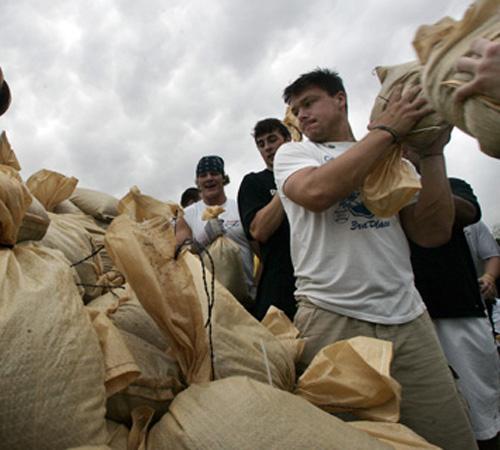University of Iowa under water

University of Iowa quarterback Jake Christensen, right, loads sand bags into a front end loader with other members of the team at the Coralville, Iowa, Streets Department facility Wednesday. Floodwaters in the Iowa City, Iowa, and Coralville areas continu Brian Ray, The Associated Press
Jun 16, 2008
Last updated on May 13, 2016 at 11:38 a.m.
IOWA CITY, Iowa – A week’s work of frantic sandbagging by students, professors and the National Guard couldn’t spare this bucolic college town from the surging Iowa River, which has swamped more than a dozen campus buildings and forced the evacuation Sunday of hundreds of nearby homes.
The swollen river, which bisects this city of about 60,000 residents, was topping out at about 31.5 feet – a foot and a half below earlier predictions. But it still posed a lingering threat, and wasn’t expected to begin receding until Monday night.
“I’m focused on what we can save,” University of Iowa President Sally Mason said. “We’ll deal with this when we get past the crisis. We’re not past the crisis yet.”
The university said 16 buildings had been flooded, including one designed by acclaimed architect Frank O. Gehry, and said others were at risk.
Get The Daily Illini in your inbox!
Iowa City Mayor Regenia Bailey said 500 to 600 homes were ordered to evacuate and hundreds of others were under a voluntary evacuation order through the morning. The city had no estimate of the number of homes that had actually flooded.
Bailey said homeowners will not be allowed back until the city determines it’s safe.
Gov. Chet Culver said it was “a little bit of good news” that the river had crested, but cautioned that the situation was still precarious.
“Just because a river crests does not mean it’s not a serious situation,” he said. “You’re still talking about a very, very dangerous public safety threat.”
After much of the University of Iowa’s Arts Campus flooded in 1993, raised walkways were installed that doubled as berms. But those were quickly overwhelmed by the Iowa River’s rising waters.
The damage would have been worse had it not been for the Herculean efforts of students, faculty, National Guard troops and others who swarmed the campus over several days to erect miles of sandbag walls, some as high as 9 feet. On Saturday alone, volunteers filled and installed more than 100,000 sandbags, said Rod Lehnertz, director of campus and facilities planning.
Lehnertz was confident that buildings that hadn’t flooded by Sunday were well-protected. He said the most pressing issue was flooding in the six miles of underground tunnels that feed steam to campus buildings for power. Workers pumped water from the tunnels into the streets and down toward the river. Some buildings at the Arts Campus on the river’s west bank had as much as 8 feet of water inside.
All elective and non-emergency procedures were canceled at the university hospital, and non-critical patients were discharged.





